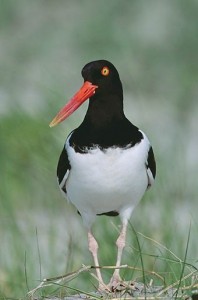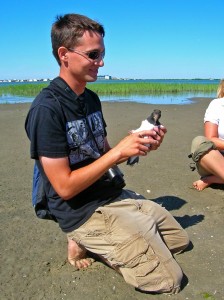Monitoring Oystercatchers in New Jersey
Banding American Oystercatchers
By Christopher Haxter, Seasonal Steward

The American Oystercatcher (Haematopus palliates) may not get as much attention as some other species since it’s not listed as endangered or threatened in New Jersey. However, it is listed as a species of special concern because the population is thought to be in decline. On Stone Harbor Point, the site I mainly monitor for my job, I spend a good deal of time finding oystercatcher nests and chicks. Together with Piping Plovers and Least Terns, oystercatchers constitute a large portion of the beach nesting birds found on “the Point”.
Oystercatchers are hard to miss; they stand nearly one and a half feet tall, are boldly colored, and have very loud calls. On average, they lay three eggs per nest, and incubate their eggs from April-June and care for their chicks from May-July. They tend to have much more trouble with predators and flooding during the egg laying stage. Once hatched, the chicks tend to have better survival rates. As of right now on Stone Harbor Point we have at least ten pairs of American Oystercatchers with offspring. One pair is still incubating a nest, nine pairs are brooding a total of thirteen chicks, and one pair has successfully fledged two chicks.
One of the ways to track these birds year after year is to put colored bands on their legs that are marked with letters and numbers so individual birds can be identified. Tom Virzi, one of our research partners (from Rutgers University), has been studying oystercatchers in New Jersey since 2004. Last week I had the privilege of helping two of his interns, Jason Pietrzak and Allison Anholt, band some oystercatcher chicks on Stone Harbor Point.

The first step was to capture the chicks. Since the chicks can’t fly yet, all we had to do was surround and grab them. Sometimes easier said than done – the two chicks we went after were already a month old, so they were quite fast. Once captured we inspected the chicks, making sure they were healthy and their legs were fully grown. The band that goes around the leg of the chick is a small orange plastic cylinder with a black number/letter code (each state participating in this banding project has a unique color). After banding, we took measurements, including beak/head/wing length, and then collected a few feathers so the chicks could be sexed using DNA analysis.
The chicks were surprisingly calm throughout the process and the parents stood near us watching carefully. When we were finished we released the chicks back to the parents and kept an eye on them to make sure the parents accepted the chicks.
Adult oystercathers are also banded, but because they can fly the process is much different and involves some trickery. To try to capture the adults we set up a decoy, played some oystercatcher calls, and placed a board lined with many tiny nooses in the sand to capture the foot of the bird. When the adults defend their territory and fight with the decoy they get caught in the trap. We did attempt this but were not successful this time.
When a banded bird is re-sighted, and the code is observed and recorded, we are able to follow them for years. The data gathered from banding oystercatchers is essential in studying their long term habits, population trends, chick survival rates, and movement patterns.
Discover more from Conserve Wildlife Foundation of NJ
Subscribe to get the latest posts sent to your email.